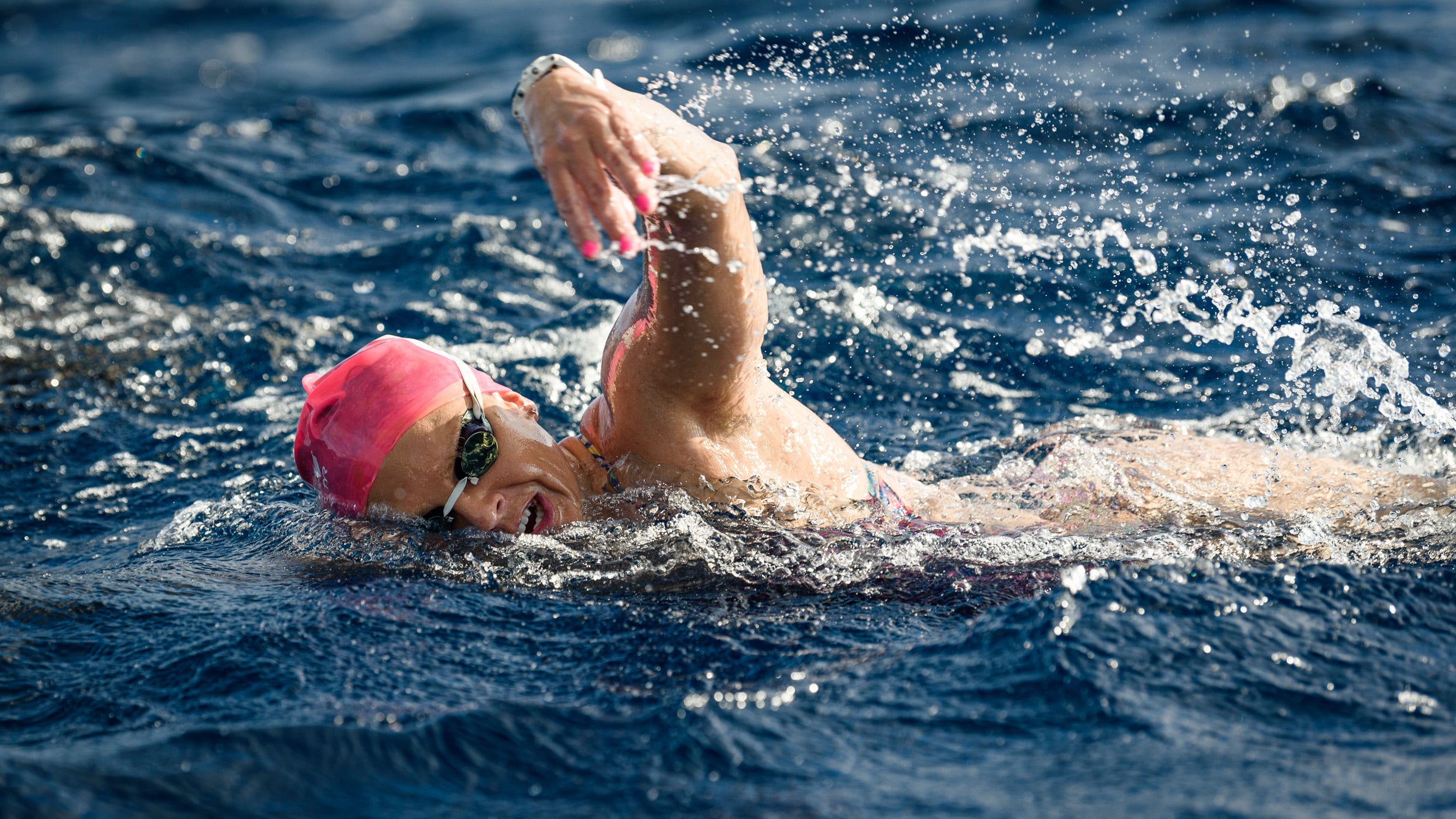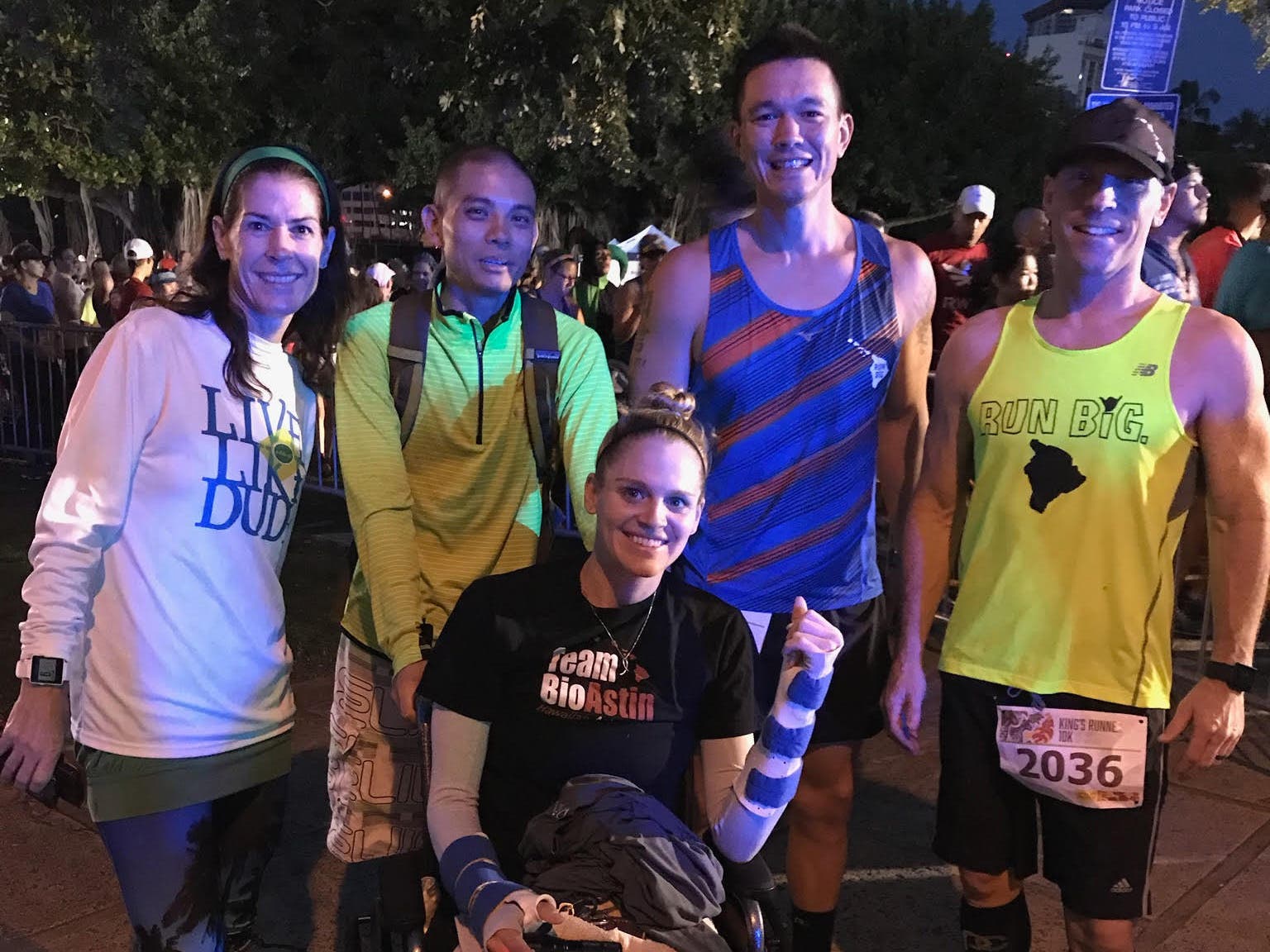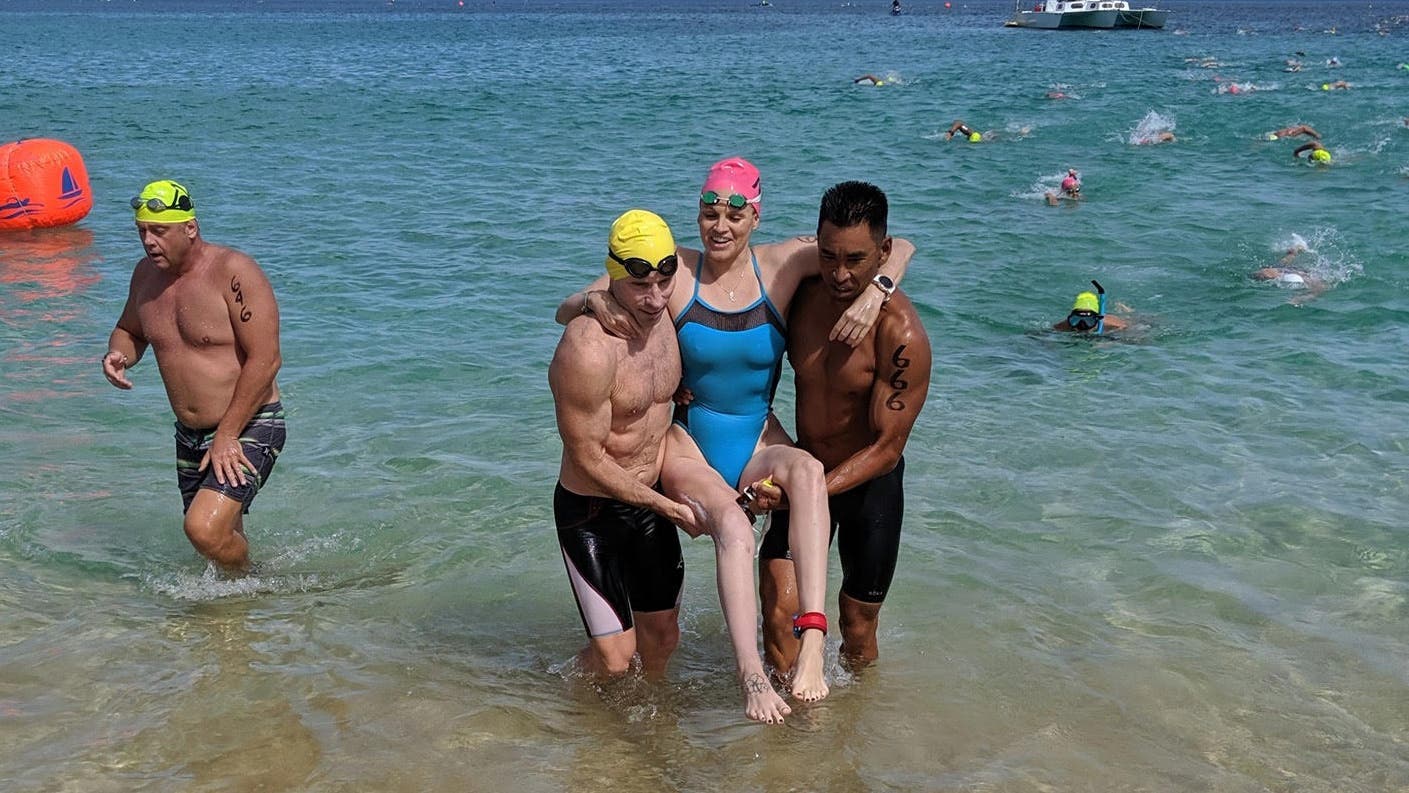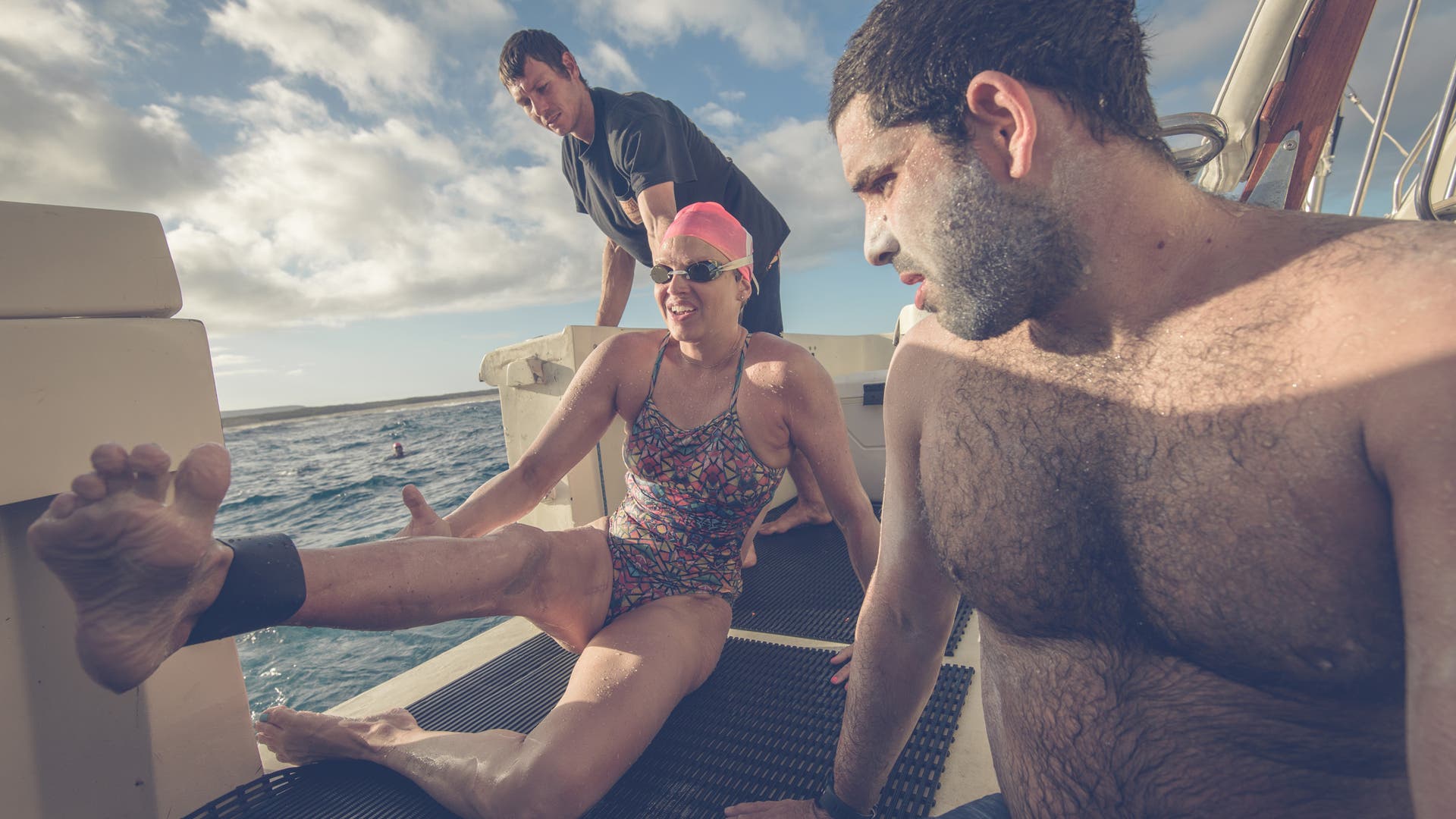After Being Hit Head-On, Lectie Altman Finds Peace and Success in the Ocean

Lectie Altman swims in the Kaulakahi channel. (Photo: Colin Cross)
Lectie Altman had been swimming for 11 hours when she got stung. A burst of pain shot across her face and arm and scalded her butt and leg, making her instantly recoil. Portuguese man-o-war. She had been stung before, but nothing like this.
“I’m getting out,” she said to the man next to her. Ryan Leong had stopped swimming to see what was wrong. He now treaded water. “No you’re not,” he said.
They had already swum 19 miles, starting at sunrise from Kauai, through sloshing, churning water with swells that at times crested four feet. Their destination, the island of Niihau, now appeared just over a half-mile away. If they could maneuver through the crashing waves over a sharp shallow reef and plant their feet in the sand, then they would join the 11-person list of those who have successfully swum the Kaulakahi channel.
Altman inspected her arm, now blooming with red welts, and reached through the water for her throbbing right leg, already covered with scars from recent surgeries. She wondered, after all this swimming and now the Portuguese man-o-war sting, would the leg even allow her to stand on shore? If she couldn’t exit the water on her own, the channel crossing wouldn’t technically count, in the rulebook of open water swimming.
“I can’t…” she said. Leong interrupted: “Lectie, relax, you’ve been through way worse!”
In January 2018, Altman, then 33, was biking a popular Oahu hill not far from her home. After climbing, along with three others, she descended—like she had dozens of times before. This time, as she approached one of the many switchbacks, she couldn’t see an oncoming car speeding and swerving into their lane. It narrowly missed her friend and training partner, Michelle Goldstein, who jumped off her bike and yelled. But the revving engine and screeching tires drowned out her warning. The car skidded through the corner and struck Altman head on, rocketing her into the air and plummeting her to the pavement.
No limb was spared. On her left arm, a compound fracture; on her right, torn tendons. Both legs had fractures, but the right was worse. “It was as if a shark bit her knee,” said Goldstein. Everything beneath her knee cap was gone. CT scans revealed more—pelvic and scapula fractures, a brain bleed, and the damage to the right knee extended in both directions, up into her thigh and down to her shin.
Over the course of multiple surgeries, doctors stabilized her bones with plates and screws, inserted cadaver tissue where her knee should have been and harvested skin from other parts of her body to cover the wounds. Infections flared. Intravenous lines were placed and more surgeries followed. She stayed in the hospital for nearly a month. Over the next year, she would return for six additional surgeries. The next year, another.
Shortly after the accident, her friend, Leong, and fellow distance swimmer Stefan Reinke visited her at the hospital. “We’re going to get you to swim a channel,” they said in an attempt to boost her spirits. It wasn’t the first time they tried to persuade her. Before winning the overall female age-group race at Ironman Boulder and Ironman Australia, Altman was a swimmer. In college, she set three individual swimming records and, more recently, she had notched the fastest overall female swim in three different Ironmans. At Ironman 70.3 Hawaii, she had been the the first out of the water overall—not just the fastest woman, but beating the men too.
“There are very few things I remember from the hospital,” said Altman, “but that is one of them. I told them they were crazy and that was never going to happen!”
She had neither the desire to brave what she called “the deep dark ocean,” nor the time to devote to channel swimming. She was a dedicated triathlete. Since 2011, in between working as a behavioral therapist and a realtor, Lectie had poured every spare moment into training and racing.
Now, in the hospital, she drew upon that same mentality. If she gritted through it, even this, she’d come out on top. Altman was so convinced she’d get better that she ordered new running shoes from her hospital bed.
But after she returned home, relegated to a wheel chair because her arms and legs were so fragile, reality gradually overwhelmed her—running, even biking, seemed less and less likely. She couldn’t even brush her own teeth. “It took me months to process how bad it really was,” she said.

When, at her insistence, her parents and friends helped her back into a pool, they said, ‘Just swim 100 yards.’ They watched from the pool deck. Someone filmed. Without stopping, she swam 1,000y.
She got stronger, upgraded to crutches, and eventually walked on her own. But pain was constant. Even the pool, her haven since the age of 6, made her feel clunky. Her right leg wouldn’t kick or bend, which meant she couldn’t push off the wall from a flip turn. Now, her left arm pulled wide, and she could feel her bone pressing against the metal plate at every stroke. The 100y splits she used to knock out in 1:10 proved impossible, even a year later. The pool became another reminder of what she couldn’t do.
Over the summer of 2019, she swam in a series of popular Oahu ocean races. It was a return, but she couldn’t really compete. She had an escort swimmer, just in case, and two people at the finish to carry her out of the water—because of that darn right leg. She smiled for pictures, but it masked a deep hurt. “I did it because I couldn’t do the other things that I wanted to do. Not because I was enjoying it,” she said.

In mid-March, as COVID-19 lockdowns took hold, nearly everything closed, including pools. Unlike other coastal states, Hawaii never restricted ocean-goers, and soon Altman began meeting up with her friends, Leong and Reinke, for early morning swims. Worried whether she’d be able to keep up, she wore fins. Two weeks later, she ditched them. As the days grew longer, they started swimming in the evenings too. On the weekends, they’d swim even more.
“We weren’t looking at times and paces on the clock,” she said. Nor did they set out to swim a certain number of yards. “It was more like, OK let’s go swim to this point.” Along the way, if they spotted something neat, they’d stop. Sea turtles, dolphins, eagle rays. Leong swam with a GoPro to snap pictures. Soon, Altman did too. “We were more just enjoying ourselves, and that helped me get out of my own head and not be so numbers-driven.”
Altman says she never agreed to swim a channel. She just showed up. Every day, every week, all summer. Along with the others, she piled swimming yards onto yards, some weeks eclipsing 30 miles. Swimming across ocean channels requires training volume above all else.
“That was the happiest I’ve seen her since the accident,” said Raul Boca, her former triathlon coach. “She was training for performance. She had a goal and she had a challenge and she was training like she used to train before.”

In July, they swam from Lanai to Maui, just over 10 miles. Then in August, they set out across Kaulakahi, from Kauai to Niihau. All day, for 11 hours, she felt good—until that Portuguese man-o-war. But Leong was right. She’d been through worse. She took a deep breath and kept going. As the sun sank to the horizon, they flattened their bodies and, in less than a foot of water, glided over knife-like reef to shore. Cautiously, Altman stood up, and, with the others, walked to the high-water mark. In 11 hours 38 minutes, she’d swam 20 miles, her longest swim yet.
“To me, the beauty of doing these channels is, it’s not necessarily about how fast you go, it’s doing it and the experience of it,” she said.
But don’t let her fool you, she still swims fast.